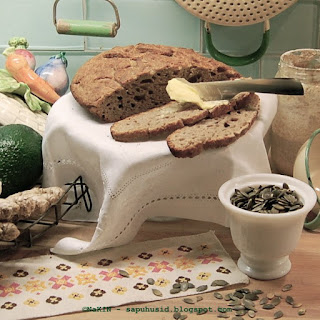 |
| The tiered cake stand is a part of our dinner service and gets a lot of use. I pile cookies and candy on it at Christmas and at other times it may store ginger, lemons or whatever. |
There is nothing wrong with the soap of course, but I had envisioned it white with smaller speckles of colour. So why exactly I used Orris root, lemongrass EO and large bits is beyond me! Except of course I had just gotten the Orris root and had to try it, I hadn't really thought about the colours of the EO's until I poured them and I thought that if I used a grater it would get too small so I chopped it into pieces. But I like the scent and I used lots of it. Maybe too much, but that was an accident.
This is also the first soap that I do with Rape seed (Canola) oil. I have always had this thing about it. I mean, it's used as a motor oil and up till recently it wasn't edible. I will still absolutely not use it as food although I might consider it's use as biodiesel.
I am rather pleased with the decoration. I have gotten these curled bits of soap when trimming and then when I saw what pretty decorations some people used them for I decided to make them especially for decoration. That was not successful and now I have no idea how I accidentally got the few that I had. Life is just really strange that way sometimes.
The recipe I used (The soap was 5% superfatted):
30% Coconut oil
30% Olive oil
25% Rape seed oil
10% Cocoa butter
5% Castor oil
I used some sugar in the water which was 30% of the oils. Maybe a little too much discount on the water, the soap was very quick to trace after I put the EO's in.
The soap bits are ends of soaps that have been coloured with Rumex oil (the pink), Annato (yellow) and Alkanet (lavender). I used 1 tsp of Titanium dioxide to get the background a bit lighter. The scent was a blend of Lavender, Rosewood, Lemongras and Ylang Ylang and I used 1 tsp of the Orris root powder to see if the fragrance lasts better.
I did try the of cuts of this soap to see what it is like and I have to say that this recipe has a very creamy lather. Don't know if that is the Rape seed oil, the sugar or just this combination. I'll get a better feel for it when it has cured. One thing that I feel that this soap could have benefitted from is a few scaps of green soap. It would have made the decoration on top a little bit more flower like. So that has to be my next soap. A green trial using dried parsley.
.



